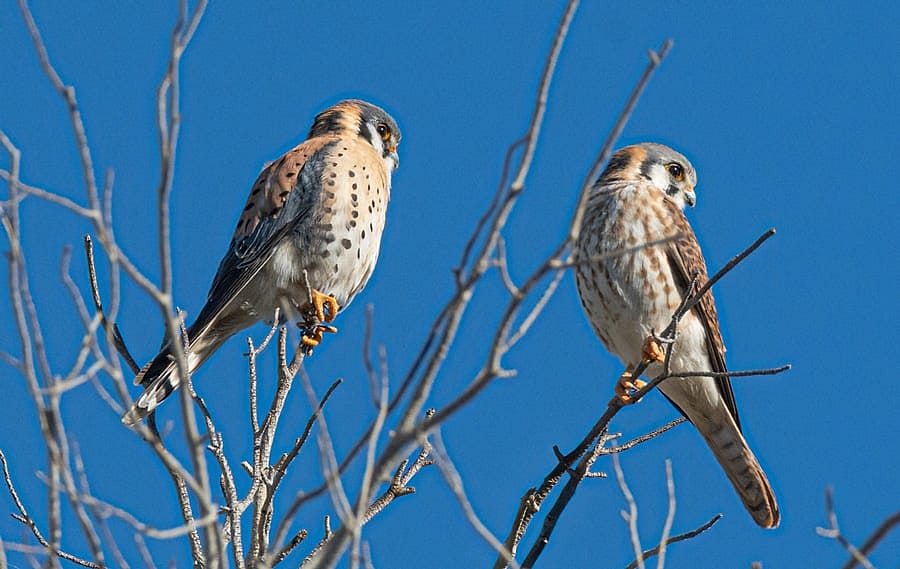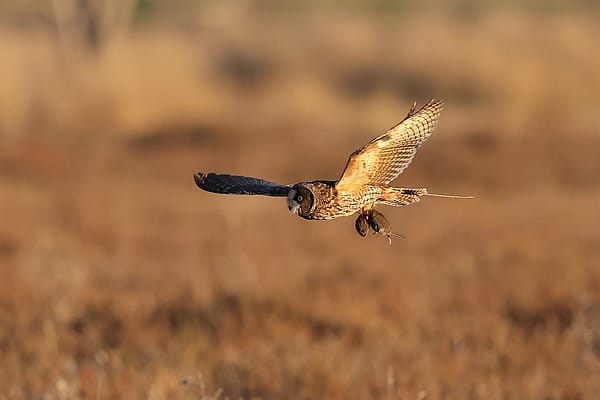
Falcons of North America

The term falcon refers to a bird of prey that has distinct differences when compared to raptors such as eagles and hawks. A few of the most common falcon characteristics are:
- Falcons typically have long, pointed wings and generally fly faster than hawks of similar sizes.
- Unlike hawks and eagles, Falcons have a tomial tooth. This is a sharp “V” shaped structure on the upper beak that matches a “V” notch in the lower beak, and can be used to sever the vertebrae of their prey.
- Falcons have tubercles, structures in their nostrils that act like a baffle to slow down air rushing into their lungs while moving at high speeds.
- On most falcon species you will find distinct dark malar stripes or cap like “helmet” pattern that extend below their eyes to reduce glare from the sun.
- Falcons tend to have very stiff feathers, and a sleek, bullet shaped body to help them slip through the air with less resistance than other raptors.
Six species of falcons reside in North America. In this blog I will discuss two interesting facts about each of these species in the order of their size, beginning with the largest, the Gyrfalcon, and ending with the smallest, the American Kestrel.
1) Gyrfalcons, pronounced JEAR-falcon, are the largest falcons in the world. Falcons cache food for consumption at a later time, so in cold weather the prey item may freeze. According to an article by Rene Ebersole in the 11-18-13 issue of the Audubon Magazine, one Gyrfalcon was seen using a “frosty dead ptarmigan like a spear of a Brazilian bbq, chipping off hunks of meat to eat as it waited out winter in the Aleutian Islands.”
2) Gyrfalcons tend to return to established territories. Researchers have analyzed fecal and feather samples at a long used nest in Greenland, and have determined that it has been used almost continuously for 2,500 years, making it the most long-term nest use documented for any raptor.
3) Here at the Draper Museum Raptor Experience, we are privileged to have two falcons. Hayabusa, our Peregrine Falcon, has been with us from the beginning. Arguably the fastest animal on the planet, these birds have been documented as being capable of reaching 242 mph when diving at prey from high altitudes. With great eyesight, these stoops may begin at 3,000 feet above its prey, and end either by striking it with balled up feet hard enough to stun or kill it; by flying past, scraping it with its sharp, open talons; or by grabbing the prey and killing it with a bite, severing the vertebra of the neck; or a combination of these.
Watch a Peregrine in a speedy dive at https://www.youtube.com/watch?v=j3mTPEuFcWk
4) According to Kate Davis’ book, Raptors of the West Captured in Photographs, Peregrines prey on over 300 species of birds in North America, up to the size of Canada Geese and Sandhill Cranes, though typically they will choose smaller birds they are capable of carrying. This load capacity would be about half of the Peregrine’s weight. So a two-pound Peregrine would be capable of carrying a prey weighing 1 pound.
5) Prairie Falcons are very close in size to Peregrine Falcons, and are among the species of birds that seem to play. Prairie Falcons have been seen dropping dried cow manure in midair, then diving to catch it. One theory is that this may be a way of learning and sharpening their coordination skills.
6) Prairie Falcons generally roost near each other when courting, however once the eggs are laid and the female begins incubating, the male generally chooses to spend the night well away from the nest. In Oregon, the night roost locations of males average 3 miles away from the nest sites.
7) Like Prairie Falcons, and many other animals, play seems to be a part of an Aplomado Falcon’s development. Soon after leaving the nest the young birds seem to play a game similar to tag, turning and diving after each other in the air. They also begin chasing other birds, even those that are much larger than themselves. It is believed that this behavior will help them to learn skills needed as hunters, therefore helping them to survive when they are on their own.
8) Aplomado Falcon pairs stay together year round, even hunting cooperatively, and sharing their prey. During nesting season, this falcon is ferocious in defending its territory. They will fly quickly at intruders they feel pose a threat, including those that are much larger than they are. Hawks, kites, and even vultures are looked upon as undesirable. Screaming loudly, they sometimes knock the intruding animal on the back of the head. They will continue this over and over until they have chased off the animal they believe is posing a threat.
9) Merlins were a favorite bird used for falconry by ladies of the court in Medieval times, due to its style of hunting. It is known that both Catherine the Great and Mary Queen of Scots used Merlins to hunt Sky Larks. Attacking prey with steep, angled dives, it will then spiral upwards, making for an exciting bird to watch. Because of this, Medieval falconers referred to Merlins as “Lady Hawks.”
10) Merlin pairs sometimes team up to hunt large flocks of small birds, such as waxwings. One of the pair will attack the flock from below, causing confusion within the flock. Moments later the second Merlin will come in, taking advantage of the confusion, to more easily make a kill.
11) The second falcon that resides here at the Buffalo Bill Center of the West is Salem, our American Kestrel. Often preferring to hunt by sitting and watching from a perch, they can also be seen hovering as they survey the ground below. Kestrels are one of the species of birds that we know are capable of seeing into the ultraviolet spectrum. With this vision, urine trails of small rodents would look like bright yellow trails, leading them right to their prey.

12) Kestrels are the smallest of the six falcons that live in North America. With most raptors, the main way to tell the sexes apart is by size, with females being the larger of the two. With kestrels it’s much easier, as they have a distinct color variation. Males have a mainly solid rufous colored tail, with a black band near the end. Females will have a barred, rufous tail. Male kestrels sport a blue-gray or slate color on the upper shoulder portion of the wings. Females carry the same rufous and black pattern seen on their backs across their upper wings. In the illustration above, although you can not see the upper wings of the middle bird, you can still identify its sex. Look carefully at the tail. What sex is this bird? If you said male, you are correct as the tail is solid until it gets to the black band near the end of the tail.
Take another look at the photo of Salem. Can you tell what sex it is?
Salem has the blue gray color on his wings, so if you said male, you are correct.
Photo Credits:
Peregrine Falcon showing pointed wings by Tom Lee, Attribution-NoDerivs 2.0 Generic license, https://www.flickr.com/photos/68942208@N02/
Gyrfalcon (Falco usti cous) perched on the ground by Olafur Larsen, Attribution License, https://commons.wikimedia.org/wiki/File%3AF%C3%A1lki_(Falco_rusticolus)_-_Gyr_Falcon.jpg
The photos of Hayabusa, our Peregrine Falcon, and Salem, our American Kestrel were downloaded from the Draper Museum Raptor Experience’s FaceBook page, https://www.facebook.com/DraperMuseumRaptorExperience/?fref=ts
Aplomado Falcon in flight by Peter K Burian, Attribution Share alike License https://commons.wikimedia.org/wiki/File:Aplomado_Falcon_at_a_falconry_center.jpg
Merlin on a glove by Camarellus, NonCommercial Attribution License, https://www.flickr.com/photos/rcmarelius/
Male and female Kestrels by Wendy Miller, Attribution-NonCommercial-NoDerivs 2.0 Generic License, https://www.flickr.com/photos/wemesq/
Written By
Anne Hay
Anne Hay has a Bachelor's degree in Elementary Education and a Master's in Computers in Education. She spent most of her working years teaching third grade at Livingston School in Cody, Wyoming. After retiring she began doing a variety of volunteer work for the Buffalo Bill Center of the West’s Draper Natural History Museum. Anne loves nature and has a concern for the environment. She believes that educating the public, so that they will have a better understanding and appreciation for the natural world, is very important. Because of this belief, volunteering at the Center is a perfect fit. She spends time in the Draper Lab, observing eagle nests for Dr. Charles Preston’s long-term research project on nesting golden eagles, writing observation reports of raptor sightings in the Bighorn Basin, and working with the Draper Museum Raptor Experience. Anne states that, “Having a bird on my glove, is one of my all time favorite things in life.”

















